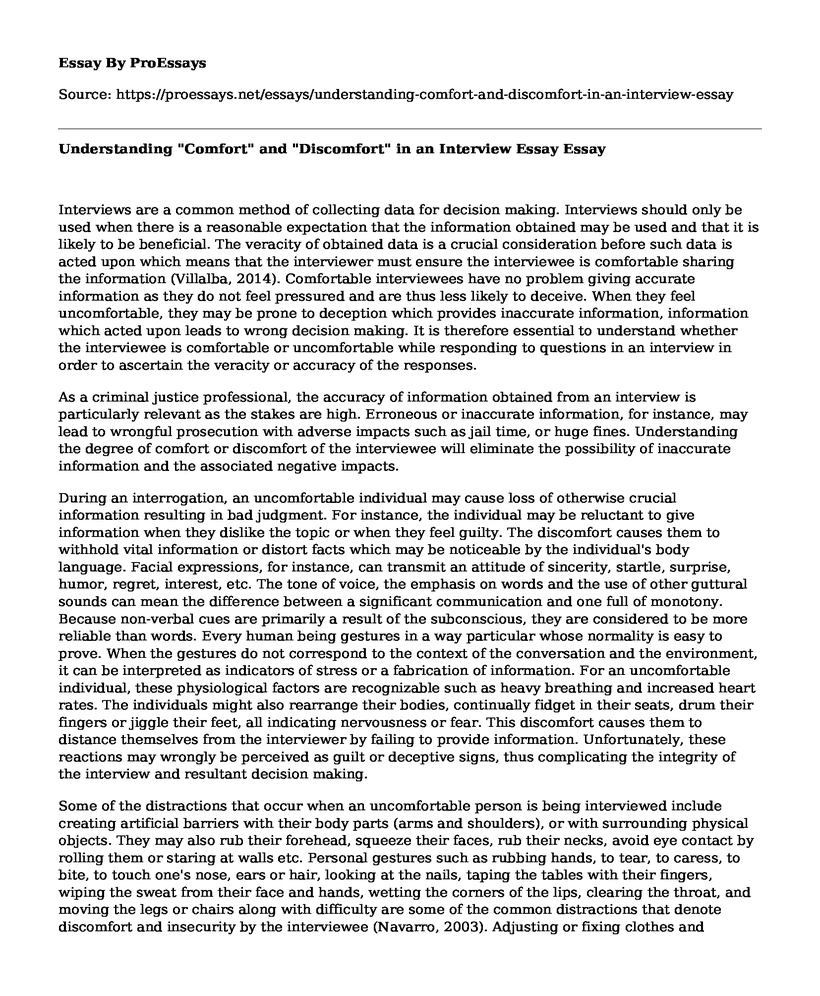Interviews are a common method of collecting data for decision making. Interviews should only be used when there is a reasonable expectation that the information obtained may be used and that it is likely to be beneficial. The veracity of obtained data is a crucial consideration before such data is acted upon which means that the interviewer must ensure the interviewee is comfortable sharing the information (Villalba, 2014). Comfortable interviewees have no problem giving accurate information as they do not feel pressured and are thus less likely to deceive. When they feel uncomfortable, they may be prone to deception which provides inaccurate information, information which acted upon leads to wrong decision making. It is therefore essential to understand whether the interviewee is comfortable or uncomfortable while responding to questions in an interview in order to ascertain the veracity or accuracy of the responses.
As a criminal justice professional, the accuracy of information obtained from an interview is particularly relevant as the stakes are high. Erroneous or inaccurate information, for instance, may lead to wrongful prosecution with adverse impacts such as jail time, or huge fines. Understanding the degree of comfort or discomfort of the interviewee will eliminate the possibility of inaccurate information and the associated negative impacts.
During an interrogation, an uncomfortable individual may cause loss of otherwise crucial information resulting in bad judgment. For instance, the individual may be reluctant to give information when they dislike the topic or when they feel guilty. The discomfort causes them to withhold vital information or distort facts which may be noticeable by the individual's body language. Facial expressions, for instance, can transmit an attitude of sincerity, startle, surprise, humor, regret, interest, etc. The tone of voice, the emphasis on words and the use of other guttural sounds can mean the difference between a significant communication and one full of monotony. Because non-verbal cues are primarily a result of the subconscious, they are considered to be more reliable than words. Every human being gestures in a way particular whose normality is easy to prove. When the gestures do not correspond to the context of the conversation and the environment, it can be interpreted as indicators of stress or a fabrication of information. For an uncomfortable individual, these physiological factors are recognizable such as heavy breathing and increased heart rates. The individuals might also rearrange their bodies, continually fidget in their seats, drum their fingers or jiggle their feet, all indicating nervousness or fear. This discomfort causes them to distance themselves from the interviewer by failing to provide information. Unfortunately, these reactions may wrongly be perceived as guilt or deceptive signs, thus complicating the integrity of the interview and resultant decision making.
Some of the distractions that occur when an uncomfortable person is being interviewed include creating artificial barriers with their body parts (arms and shoulders), or with surrounding physical objects. They may also rub their forehead, squeeze their faces, rub their necks, avoid eye contact by rolling them or staring at walls etc. Personal gestures such as rubbing hands, to tear, to caress, to bite, to touch one's nose, ears or hair, looking at the nails, taping the tables with their fingers, wiping the sweat from their face and hands, wetting the corners of the lips, clearing the throat, and moving the legs or chairs along with difficulty are some of the common distractions that denote discomfort and insecurity by the interviewee (Navarro, 2003). Adjusting or fixing clothes and jewelry, removing imaginary lint from clothes and cleaning the glasses indicate nervousness and anxiety, all of which are indicators of discomfort.
Conclusion
These modes of speech significantly impact on the interview process, especially with an uncomfortable interviewee. If they feel uncomfortable, they may intentionally withhold vital information or provide inaccurate data. The interviewer should not forget the significant meaning of these non-verbal cues and that it is important to observe non-verbal language during the development of the interview or interrogation while asking the questions, in the development of the respondent's responses in order to get valuable information in the investigation. The consequence of discomfort on the interviewee triggers antipathy or dishonesty to the interviewer, which in effect renders the interview useless or of limited value.
References
Navarro, J. (2003). A Four-Domain Model for Detection Deception: An Alternative Paradigm for Interviewing. FBI L. Enforcement Bull., 72, 19.
Villalba, D. K. (2014). The Effect of Rapport Building in Police Interrogations: Can Rapport Improve the Diagnosticity of Confession Evidence?.
Cite this page
Understanding "Comfort" and "Discomfort" in an Interview Essay. (2022, Jul 19). Retrieved from https://proessays.net/essays/understanding-comfort-and-discomfort-in-an-interview-essay
If you are the original author of this essay and no longer wish to have it published on the ProEssays website, please click below to request its removal:
- Paper Example on Jensen and Meckling: Agency Conflicts and Costs
- Leadership Styles Reflection Essay
- Paper Example on Gun Laws
- Essay Example on TechFite: Securing Growing Business With Real-Time Log Files
- Essay Sample on Secure Courtrooms: Deterring Potential Threats
- Essay Sample on Technological Advancements in Criminal Justice: Safeguarding Cities & Enhancing Legal Cases
- Research Paper Sample on Absent Fathers & Crime: Examining the Link







